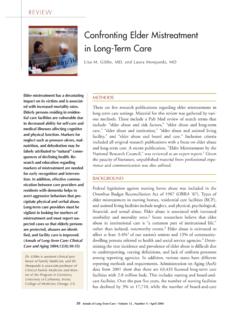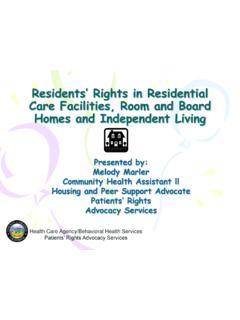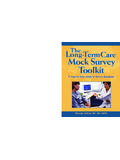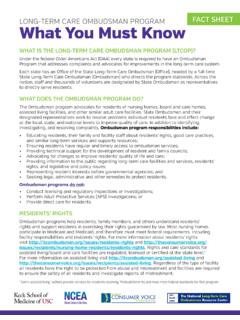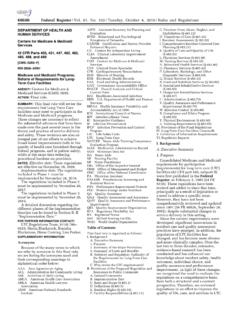Transcription of Elder Abuse in Long Term Care Facilities
1 Elder Abuse in long Term care FacilitiesPresented by Rochelle Shelley WooleryOmbudsman CoordinatorCouncil of Aging-Orange County Private, non-profit corporation dedicated to promote adult empowerment, prevent Abuse and advocate for the rights and dignityof those experiencing health and aging challenges. Founded in 1973 and supported by federal and state programs, community funds, and private contributionsLong-Term care OmbudsmanProgram Governed by the Older American s Act of 1978 and by California law. The State Health and Human Services Agency, Department of Aging administers the statewide long -Term care Ombudsman program through 33 Planning and Service Areas located throughout the state. Managed by the Council on Aging-Orange CountyLong-Term care OmbudsmanProgram Mission Statement: Making justice and human dignity a reality for all individuals who reside in long -term care Facilities through advocacy, mediation, complaint-investigation and resolutionWhat long -Term care Ombudsmen Do Mandated by state and federal lawto visit Orange County s licensed nursing and residential care Facilities for the elderly at leastonce a month and investigate any suspected Abuse or neglect Address ALL complaints from relatively minor complaints about cold food to more serious complaints about short staffing and inadequate medical careDifferent Types of Facilities Skilled Nursing Facilities : Commonly referred to as nursing homes, these Facilities provide skilled care under the supervision of medical professionals Residential care Facilities for the Elderly.
2 Also referred to as board and care homeor assisted living Facilities , these Facilities provide housing, meals, and personal services in a family-like atmosphere. RCFE s serve people who are no longer able to perform all their activities of daily living but who do not require medical careAbuse in long -Term care Facilities Residents are typically very frail or disabled, and often suffer from Alzheimer s disease and other making them more vulnerable to Abuse Offenders may be other residents, visitors (including family) or individual staff members May be the result of either personal characteristics (of personnel) or systemic problems (within Facilities )Types of Abuse Physical Abuse Sexual Abuse Verbal and Mental Abuse Financial Abuse Neglect Self-Neglect Isolation and Violations of Rights Institutional Abuse and Neglect Abduction AbandonmentMaking a Report Mandated reporters are requiredto report incidents of known or suspected Abuse in two telephone immediately or as soon as practically possibleto local ombudsmen orthe local law enforcement written report, Department of Social Services Form (SOC form 341) sent within two working daysWhere Reports Come From From mandated reporters, as well as family members and friends, other residents or victims May be reported during an Ombudsman s routine visits, by phone, or by office visit Who Investigates Reports of Abuse in Facilities ?
3 long -Term care Ombudsman Program Local Law Enforcement The Department of Justice, Bureau of Medi-Cal Fraud and Elder Abuse Additionally, reports are sent to the individual licensing agency responsible for licensing long -term care facilitiesNOTE: Adult Protective Services (APS) accepts and investigates reports of Abuse and neglect to elderly and dependent adults who live in private homes and apartments Conducting an Investigation The purpose of the Ombudsman s investigation is to verify Abuse and focus on victim s needs Ask residents for permission to collect info Interview witnesses Review medical records It does NOT take the place of a criminal investigationHow to Contact an Ombudsman All licensed skilled nursing Facilities and residential care Facilities for the elderly are required by law to prominently display the Ombudsman poster listing our services and contact number: (714) 479-0107 (800) 300-6222 Statewide Ombudsman toll free 24-hour CRISIS line 1-800-231-4024 Things to Think US Census Bureau projects that California s elderly population will nearly doublewithin the next 20 years from million to over million More than 43 percent of all Americans over the age of 65 will reside in a nursing home sometime in their remaining lives.
4 Nationally, one or every 20 elderly people will be a victim of neglect Abuse each year More than two-thirds of abusers are family membersQuestions and

